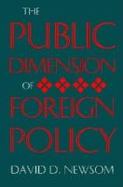The Public Dimension of Foreign Policy
- List Price: $37.95
- Binding: Hardcover
- Publisher: Indiana Univ Pr
- Publish date: 03/01/1996
Description:
How does US foreign policy get made? Why are official statements on foreign policy so often unclear? What influences shape citizens' perceptions of international events? Who supplies the money for public advocacy of global issues? What is the influence of academic in government decisions? Why has Congress become the catalyst in the national debate on US foreign policy? In The Public Dimension of Foreign Policy, former Under Secretary of State and Ambassador David Newsom offers a trenchant analysis from a long-term insider's point of view of how our foreign policy is shaped and sometimes mis-shaped. Beginning with an explanation of the constitutional basis of free expression and public pressures, the book's twelve chapters examine the elements that combine to create both perceptions of events and the impetus for action. Newsom's thesis is that in the United States the public, including the press, bolstered by the First Amendment, plays a major role in shaping our foreign policy. Although some of the policy-making process is secret, the success of the American democracy ultimately depends on public support. Creation of that support involves the White House, numerous agencies, and nearly every cabinet department in an effort to control the flow of information through the print media, radio, and television. The desire for secrecy is constantly at war in our society with the media's power to make information public, and many institutions outside the government are constantly trying to influence the process. Newsom discusses the reporting dimension, conflicting objectives within the government, the influence of money in various forms, the influence of think tanks and lobbies, and finally therole of Congress itself. The chasm dividing the scholarly from the practitioner's view of foreign policy is brilliantly dissected in the chapter on Academia. Detailed case studies look at the negotiations over the Strategic Arms Limitation Treaty (SALT II): Nicaragua after the fall of Somoza, apartheid in South Africa, and the civil war in Angola. This book is full of practical insights from a keen observer. It is a must for anyone who wishes to understand how the United States makes its foreign policy.
Expand description

Please Wait

